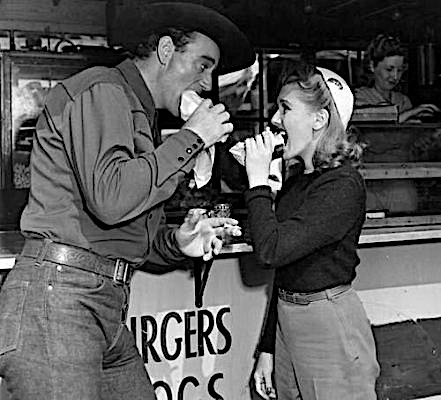MARIANI’S
Virtual
Gourmet
March
5, 2023
NEWSLETTER
THIS WEEK
THE TASTES OF JAMES BOND:
YOU ONLY LIVE TWICE
By John Mariani
NEW YORK CORNER
IXTA
By John Mariani
GOING AFTER HARRY LIME
CHAPTER TEN
By John Mariani
NOTES FROM THE WINE CELLAR
A WIDE RANGE OF PASSOVER
WINES NOW AVAILABLE
By Geoff Kalish
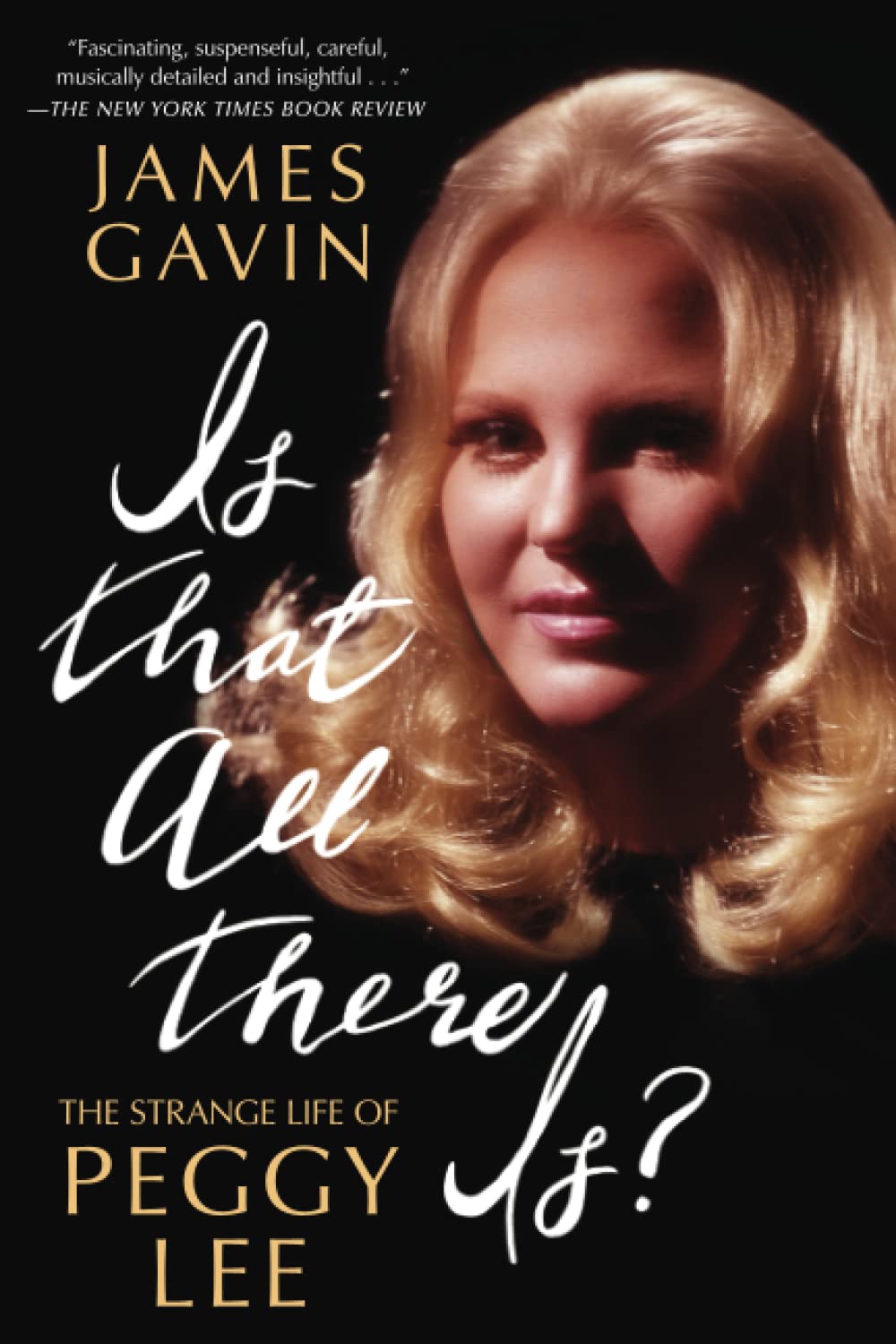 Gavin,
biographer of PEGGY LEE. Go to: WVOX.com.
The episode will also be archived at: almostgolden.
Gavin,
biographer of PEGGY LEE. Go to: WVOX.com.
The episode will also be archived at: almostgolden.
THE TASTES OF JAMES BOND
YOU ONLY LIVE TWICE
By John Mariani

 You Only Live Twice (1964),
the eleventh and last of Ian Fleming’s James
Bond novels, was by far the most crammed
with food and drink references, starting off
with several chapters concerning Bond’s
excessive drinking, caused by his grief over
the murder of his wife by Ernst Blofeld in On Her
Majesty’s Secret Service. Right
at
the beginning Bond is being entertained by a
geisha named “Trembling Leaf” and drinking
sake from a flask (“rather than these
ridiculous thimbles”) with his Japanese
counterpart, Tiger Tanaka, who says only
Sumo wrestlers drink as much as Bond,
calling him an “eight-flask man.”
You Only Live Twice (1964),
the eleventh and last of Ian Fleming’s James
Bond novels, was by far the most crammed
with food and drink references, starting off
with several chapters concerning Bond’s
excessive drinking, caused by his grief over
the murder of his wife by Ernst Blofeld in On Her
Majesty’s Secret Service. Right
at
the beginning Bond is being entertained by a
geisha named “Trembling Leaf” and drinking
sake from a flask (“rather than these
ridiculous thimbles”) with his Japanese
counterpart, Tiger Tanaka, who says only
Sumo wrestlers drink as much as Bond,
calling him an “eight-flask man.” 
Back in London, M, his superior at MI6,
tells a neurologist Bond’s drinking has
affected his work, saying “he isn’t any
longer” the agency’s best man, even
considering relieving him of is 00 number. The
neurologist suggests a new mission would snap
Bond out of his morose temperament.
Dispatched as a diplomat to Japan, Bond
first takes his assistant Mary Goodnight to a
dinner of roast grouse and Champagne at
Scott’s restaurant before flying on a Japan
Airlines DC-8 to Tokyo, where he checks into
the Okura
(below)hotel. There he meets an
Australian contact named Dikko Henderson, who
takes him for serious drinking in the Ginza at
Melody’s Bar and a dinner of unagi (eel)
and Suntory whiskey.
 The next day Tanaka tells Bond his job
is to assassinate Dr. Guntram Shatterhand, who
makes deadly poisons in his “Garden of Death.”
To do so Bond must disguise himself as a mute
Japanese peasant miner named Taro Todoroki,
who can get on Shatterhand’s estate. Before
doing so, Tanaka invites Bond to a dinner of
quail’s eggs, seaweed and live lobster, of
which Bond says, “Shimata!
(Damnit!) I have made a mistake. It crossed my
mind that honorable Japanese lobster might not
like being eaten alive.” The next day Tanaka
takes him to a Kobe beef farm and a local
restaurant to eat the specialty “of the grade
you wouldn’t find in the most expensive
restaurant in Tokyo,” with a saucer of blood
that Bond refuses.
The next day Tanaka tells Bond his job
is to assassinate Dr. Guntram Shatterhand, who
makes deadly poisons in his “Garden of Death.”
To do so Bond must disguise himself as a mute
Japanese peasant miner named Taro Todoroki,
who can get on Shatterhand’s estate. Before
doing so, Tanaka invites Bond to a dinner of
quail’s eggs, seaweed and live lobster, of
which Bond says, “Shimata!
(Damnit!) I have made a mistake. It crossed my
mind that honorable Japanese lobster might not
like being eaten alive.” The next day Tanaka
takes him to a Kobe beef farm and a local
restaurant to eat the specialty “of the grade
you wouldn’t find in the most expensive
restaurant in Tokyo,” with a saucer of blood
that Bond refuses.
Bond stays at the Miyako, where
he orders eggs Benedict and a pint of Jack
Daniels Tennessee whiskey, and afterwards
boards the  Murasaki
Maru cargo ship (right) and
arrives at the town of Beppu, checking into an
inn and enjoying five flasks of sake along
with fugu
(below), the poisonous fish that only a
trained chef can make edible. Bond finds it
tasteless.
Murasaki
Maru cargo ship (right) and
arrives at the town of Beppu, checking into an
inn and enjoying five flasks of sake along
with fugu
(below), the poisonous fish that only a
trained chef can make edible. Bond finds it
tasteless.
He begins training with a former movie
actress named Kissy and enjoys all-seafood
meals with dried seaweed and bean curd. She
also slips an aphrodisiac into his sukiyaki.
 At Shatterhand’s estate Bond finds
Blofeld, dressed as a samurai. Blofeld
challenges
him to a duel, with Blofeld wielding a sword
and Bond a wooden staff. Bond kills Blofeld,
then blows up the castle, but during his
escape he suffers a head injury that causes
serious amnesia. His death is reported in the
press.
At Shatterhand’s estate Bond finds
Blofeld, dressed as a samurai. Blofeld
challenges
him to a duel, with Blofeld wielding a sword
and Bond a wooden staff. Bond kills Blofeld,
then blows up the castle, but during his
escape he suffers a head injury that causes
serious amnesia. His death is reported in the
press.
He is nursed by Kissy, and lives as a
fisherman Kissy becomes pregnant and hopes
to marry him, but reading a newspaper story
about Vladivostok that makes him believe he
had a history in Russia that might jog his
memory.
pregnant and hopes
to marry him, but reading a newspaper story
about Vladivostok that makes him believe he
had a history in Russia that might jog his
memory.
The movie
version of You
Only Live Twice (1967), starring Sean
Connery, has little of the gourmand nature
of the novel and no reference to 007’s
dissolute drinking.
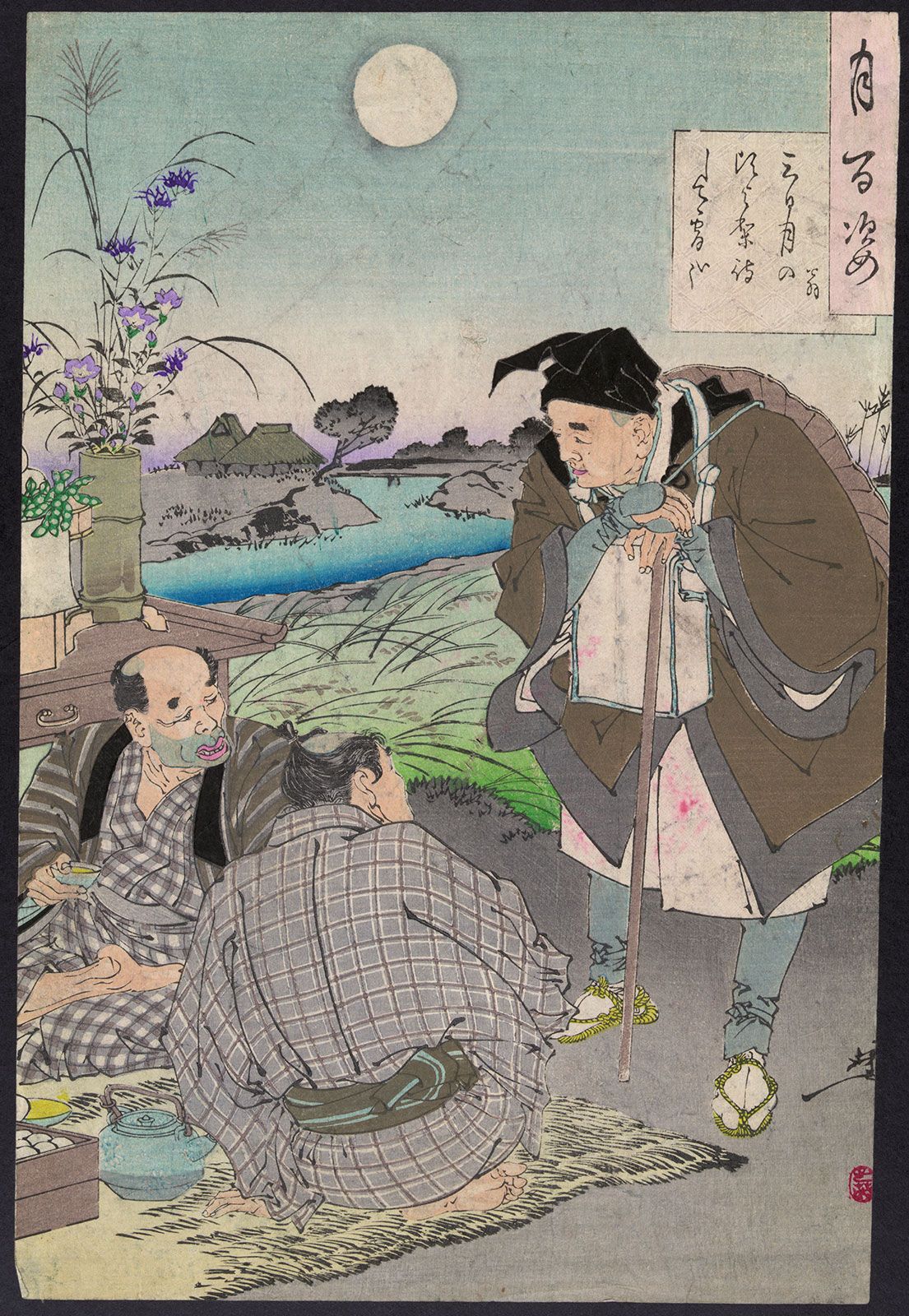 The
title for both came from a haiku by Matsuo
Bashō (left)—“You only live twice/Once
when you are born/And once when you look death
in the face,” although the lyrics of the
film’s score (which was a hit for Nancy
Sinatra) read “Once in your life and once in
your dreams,” referencing the first scene, in
which 007 is seen to be murdered by assassins
while he is in bed with a Hong Kong girl, who
had asked him if Chinese women taste different
from western women. Bond answers, “Like Peking
duck is different from Russian caviar, but I
love them both.”
The
title for both came from a haiku by Matsuo
Bashō (left)—“You only live twice/Once
when you are born/And once when you look death
in the face,” although the lyrics of the
film’s score (which was a hit for Nancy
Sinatra) read “Once in your life and once in
your dreams,” referencing the first scene, in
which 007 is seen to be murdered by assassins
while he is in bed with a Hong Kong girl, who
had asked him if Chinese women taste different
from western women. Bond answers, “Like Peking
duck is different from Russian caviar, but I
love them both.”
Bond’s murder is, however, a ruse to
fool enemies into thinking him dead, with even
a mock burial at sea from the HMS Tenby
(below).
Instead, he shows up on a British submarine
where he meets M and Q, who order him to
investigate the hijacking of a NASA Jupiter 16
spacecraft in the Sea of Japan. 
In Tokyo, he meets Dikko Henderson, who
offers 007 a Martini, which Bond notices is
not shaken to his preference and is Russian
vodka, which is probably Stolichnaya.
Henderson is killed before he can relay
details about the spacecraft. Bond pursues the
assassin and kills him, taking his clothes so
he can be driven in the getaway car to Osato
Chemicals, where Bond breaks into the office
safe to steal secret documents of the
company's president, Mr. Osato. While there he
fights and kills one  of Osato’s
men, hiding the body in a liquor cabinet from
which he takes a shot of vodka, toasts the man
he’s just killed, then finds the vodka tastes
terrible, looks at the label and sees it’s
Siamese, not Russian.
of Osato’s
men, hiding the body in a liquor cabinet from
which he takes a shot of vodka, toasts the man
he’s just killed, then finds the vodka tastes
terrible, looks at the label and sees it’s
Siamese, not Russian.
Bond is chased by Osato’s men, but is
picked up by agent Aki, who then runs into a
subway station where Bond follows, only to
fall down a trap door that enters upon Tiger
Tanaka’s headquarters. There they pore over
the documents and find a photo of the cargo
ship Ning-Po,
with a microdot message saying the
tourist who took the photo was killed 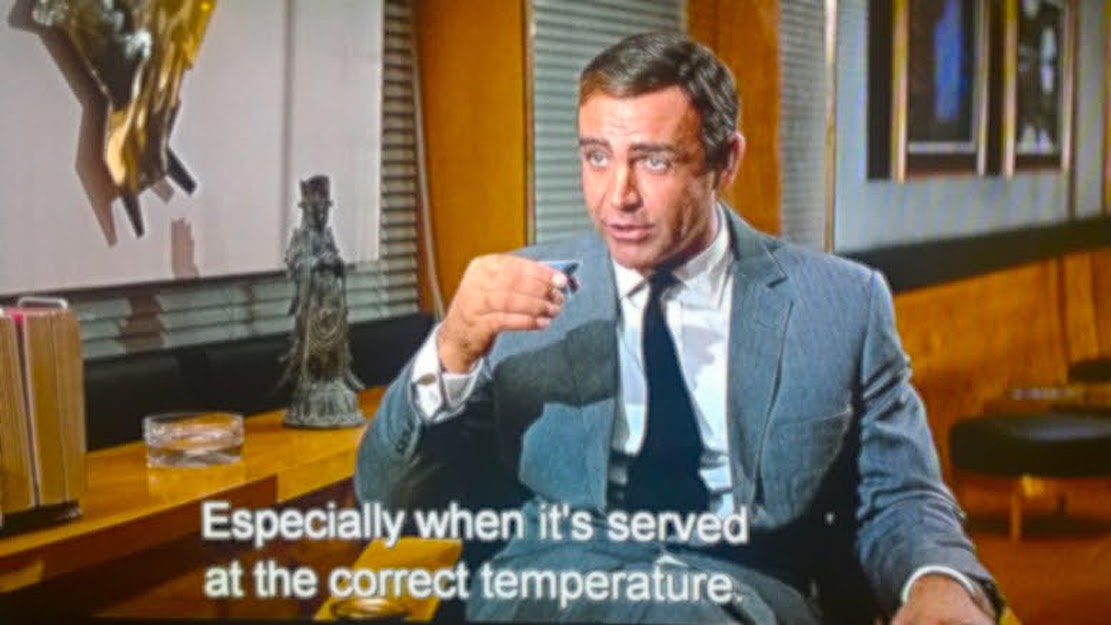 as
a security precaution.
as
a security precaution.
Tanaka takes Bond on his private train,
offers him a Martini but Bond says he’d prefer
sake, which he says he enjoys “especially when
it’s served at the right temperature—98.4
degrees Fahrenheit.”
Bond
returns to Osato’s, posing as a potential
buyer. Osato offers him a glass of Dom
Pérignon ’59. Osato is revealed to be part of
SPECTRE and orders 007 to be killed, but he
escapes a group of henchmen, again rescued by
Aki, who drives him to Kobe, where the Ning-Po (left)is docked.
They find the ship was used to transport
rocket fuel.
 They
are again pursued and Aki gets away while Bond
is captured, knocked unconscious and tied up
on the Ning-Po
. Osato’s beautiful secretary Brandt
interrogates Bond, then seduces him. They fly
to Tokyo, but Brandt bails out of the plane,
leaving Bond to land the craft before planted
explosives go off. In Tokyo he checks into the
Hilton
Hotel (below).
They
are again pursued and Aki gets away while Bond
is captured, knocked unconscious and tied up
on the Ning-Po
. Osato’s beautiful secretary Brandt
interrogates Bond, then seduces him. They fly
to Tokyo, but Brandt bails out of the plane,
leaving Bond to land the craft before planted
explosives go off. In Tokyo he checks into the
Hilton
Hotel (below).
A Soviet spacecraft is then hijacked
and brought to Blofeld’s lair  within
a hollowed-out volcano. The intent is to start
a war between the U.S. and U.S.S.R. Blofeld
blames Osato and Brandt for their failure to
finish off Bond. He throws Brandt into a pool
of piranhas and demands Osato rid him of Bond
once and for all.
within
a hollowed-out volcano. The intent is to start
a war between the U.S. and U.S.S.R. Blofeld
blames Osato and Brandt for their failure to
finish off Bond. He throws Brandt into a pool
of piranhas and demands Osato rid him of Bond
once and for all.
Meanwhile, Bond undergoes training with
Tanaka’s ninja fighters at the Himeji
Castle in Kyoto. He also trains to
be a fisherman diver, changes his western
appearance and has a fake wedding to Kissy
Suzuki, where they drink sake. That night he
begins to eat an oyster, but, realizing he
will not be sleeping with Kissy, stops.
Together they reconnoiter
at the volcano, Bond sneaks in, frees the U.S.
and Soviet astronauts and takes control of the
launch room wherein Blofeld plans to shoot off
the ICBMs. Bond puts them on self-destruct as
Tanaka’s men attack the volcano, which
explodes after the ninjas, Bond and Kissy
escape.
Injured and suffering sever
amnesia, Bond is nursed back to health by
Kissy, who becomes pregnant, Bond is ready to
marry her, but then reads a newspaper story
about Vladivostak that jogs his memory about
once having been there.
❖❖❖
IXTA
299 Bowery
917-732-4982
By John
Mariani
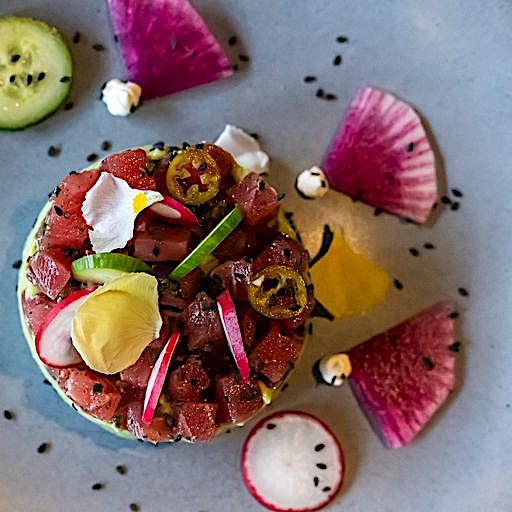
For the past couple of years there
has been a growing number of Mexican
restaurants, some run by Americans, that have
taken traditions of regional fare from Oaxaca,
Baja, Monterey and Guadalajara and transformed
them with both respect and commitment to
better ingredients of the kind you find in the
huge city markets south of the border. I
have every reason to believe that the growth
in numbers will increase, with more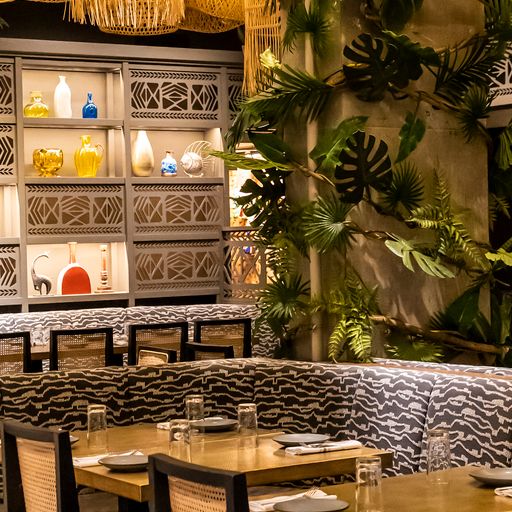 and more diversity, largely because Americans
are already very familiar with Mexican food in
a way they are not with recent trendy cuisines
like Nordic, Peruvian and Korean.
and more diversity, largely because Americans
are already very familiar with Mexican food in
a way they are not with recent trendy cuisines
like Nordic, Peruvian and Korean.
Ixta is a fine new example on The Bowery,
having taken over the crushingly loud DBGB
Kitchen & Bar, which closed in 2017. You’d
hardly know the place now, for what was once a
lackluster and colorless room is now an
evocation of bold Latino hues and decorations,
including intricately hand-carved totem columns
and a 12-foot hand painted Tulum-inspired jaguar
named “Perla” by local artist Fernando Leon and
animated NFTs projected throughout the
restaurant, created by artist Ken Forbes. There
are 165 seats and 10 at the bar, where the
collection of tequilas and mezcals is  impressive
and go well in the array of exotic cocktails
created by Miami native Jenny Castillo.
impressive
and go well in the array of exotic cocktails
created by Miami native Jenny Castillo.
On a midweek
night when the place was about three-quarters
full the noise level in the dining room was not
bad at all, at least after the pounding techno
disco music was turned down. (The owners say
they are re-thinking the music.) In
search of the meaning of the name Ixta, I found
that it may derive from an Aztec legend of a
princess turned into the Iztacchihuatl volcano.
Owners Mike Himani, Erol West and Marcelo
Martins feature a menu with many Oaxacan dishes
in modern versions by Mexico City-born chef
Francisco Blanco, previously at Le Cirque. His
menu is categorized under appetizers, raw bar,
salads, tacos, entrees, specials and sides, and
pretty much everything is made to be shared.
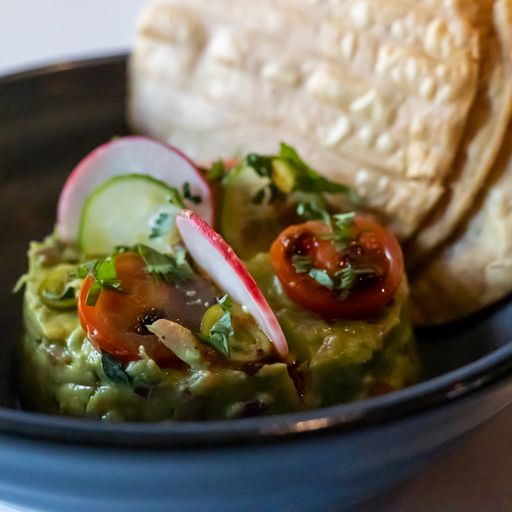 You
certainly want a bowl of guacamole studded with
pepitas,
salsa matcha and Serrano chilies ($18).
Really innovative is the dish of truffled tamale
tots with plenty of gooey cheese and prosciutto
($32), a dish not to be missed. Smoked and
mezcal-cured salmon—not a fish I associate with
any part of Mexico—came sloppily atop corn
crisps with sesame and salmon roe ($26), and
just didn’t work.
You
certainly want a bowl of guacamole studded with
pepitas,
salsa matcha and Serrano chilies ($18).
Really innovative is the dish of truffled tamale
tots with plenty of gooey cheese and prosciutto
($32), a dish not to be missed. Smoked and
mezcal-cured salmon—not a fish I associate with
any part of Mexico—came sloppily atop corn
crisps with sesame and salmon roe ($26), and
just didn’t work.
What did work was a delicious, nicely
seasoned tuna tostada
with a Japanese Morita ponzu,
creamy avocado and black sesame ($23). The best
ceviche
to have is the combination of catch of the day,
octopus,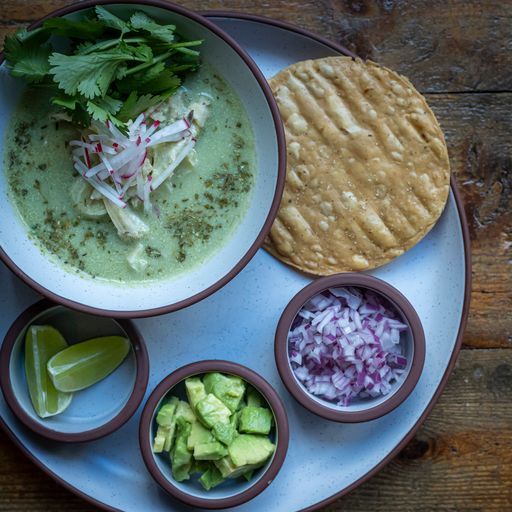 and shrimp
with jalapeño, leche de
tigre citrus marinade and heirloom tostadas ($27).
and shrimp
with jalapeño, leche de
tigre citrus marinade and heirloom tostadas ($27).
Another unusual entry is the “original birria”
($21), a dish from Jalisco, composed of slowly
cooked goat’s meat that retains all its juices,
guacamole mousse, corn tortillas
and a salsa
taquera in a consommé. Straightforward
crispy hake was done with a tomato and
beer-based salsa
borracho, jicama slaw and flour tortilla
($21). These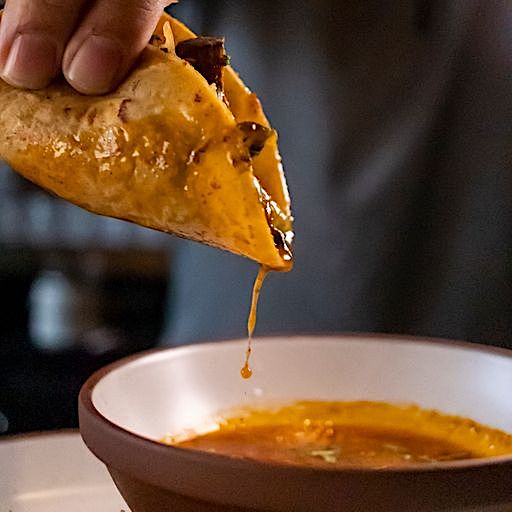 are dishes fit for main courses, and,
in fact, are somewhat more interesting than the
entrees like the New York strip steak and
roasted chicken. I do want to go back and try
the enchiladas
divorciadas ($27) of mole rojo
and mole
negro with vegetables.
are dishes fit for main courses, and,
in fact, are somewhat more interesting than the
entrees like the New York strip steak and
roasted chicken. I do want to go back and try
the enchiladas
divorciadas ($27) of mole rojo
and mole
negro with vegetables.
The specials on the menu include a whole
branzino with avocado, tortillas
and salsa,
lemon and the smart addition of kurakake,
usually made with dried fish and seaweed, which
adds a further scent and taste of the ocean
($40).
Esquites
is made with corn, turmeric, Parmesan
cheese, and ancho chile
ashes with a lemon emulsion ($12) as a side
dish. 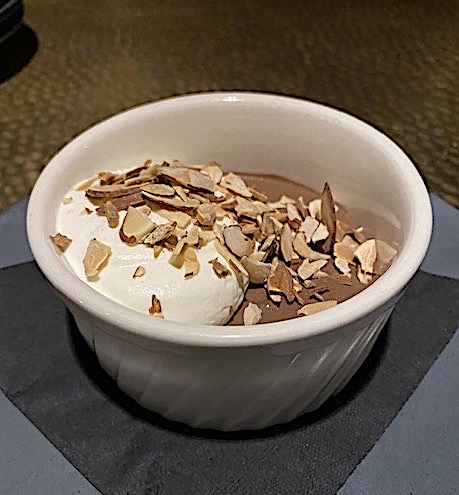
Most of the time I look askance at the
big-boned tomahawk steak, but Ixta’s is really
superlative for its beefy taste, well enhanced
by roasted sweet peppers, caramelized onion, sea
salt and pico
de gallo. The $200 price tag is high, but,
weighing in at two pounds, it will readily serve
four people.
A delectable way to end off the meal is
with either the fat, sugared fried bombolones
with a scoop of ice cream or the rich Mexican
chocolate pudding (right).
No one
leaves hungry at Ixta. In fact, you’ll
likely leave with food for tomorrow, but more
important, you’ll leave with a new sense of the
regional variety and enticing seasoning of
Mexican food of a kind you haven’t had before in
this city.
Open
for dinner nightly, for brunch Sat. & Sun.
GOING AFTER HARRY LIME
By John Mariani
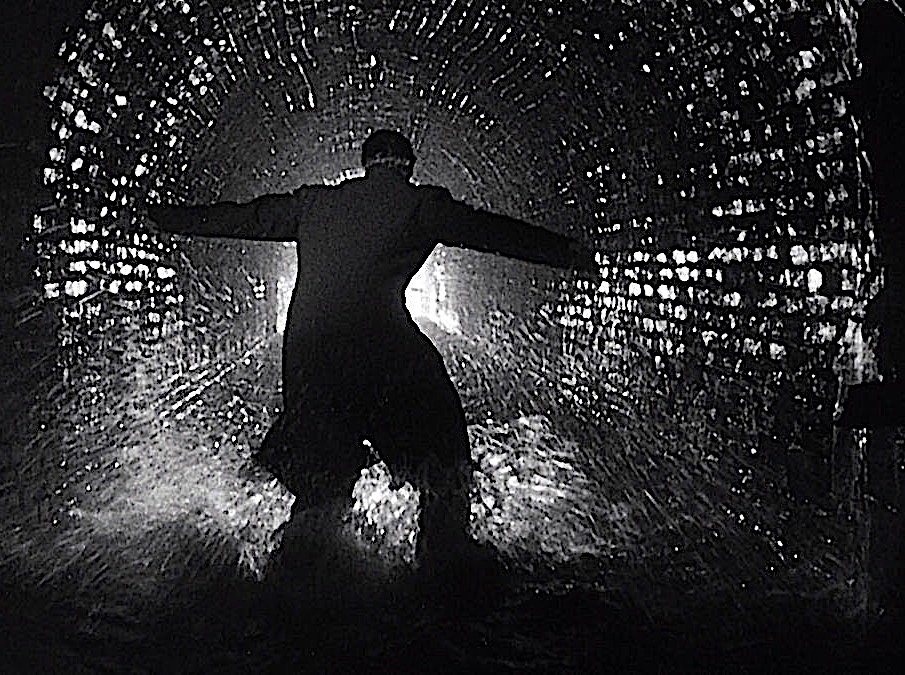
CHAPTER TEN
 There
were about twenty boxes on the cart. David
took a deep breath and opened the first. A
half-hour later the second, but by then he’d
learned what files could be run through quickly
or discarded. Indeed, most of the files were
bureaucratic correspondence about rules and
regulations, hierarchies and legal documents. As
he had with the American files, David was
basically looking for two things: Names of
criminals identified as working in Vienna from
1945 to 1950 and any allusions to drug
trafficking that might include selling illegal
pharmaceuticals.
There
were about twenty boxes on the cart. David
took a deep breath and opened the first. A
half-hour later the second, but by then he’d
learned what files could be run through quickly
or discarded. Indeed, most of the files were
bureaucratic correspondence about rules and
regulations, hierarchies and legal documents. As
he had with the American files, David was
basically looking for two things: Names of
criminals identified as working in Vienna from
1945 to 1950 and any allusions to drug
trafficking that might include selling illegal
pharmaceuticals.
By one o’clock he’d gotten through half the
files and decided to work through lunch in an
effort to polish off the rest by the end of the
afternoon. Katie
and he had allotted a week in London to do their
research, so he needed to maximize his work time,
especially since the files could be vast, even if
few were revealing of anything.
Ms. Hurley came in from time to time to ask
if David needed anything—A glass of water,
perhaps? Fresh pencil?—but he smiled and said no
and went back to work. There wasn’t much of what
he was looking for in the files and he suspected
that asking for many more carts would be just as
unproductive.
He did find the names of British officers
who served in Vienna during that time in various
jobs, and he copied down those particularly active
during the time Graham Greene would have been
doing his own research for the movie’s script. David
doubted many would still be alive in 1999,
especially the upper ranking officers, so his list
was narrowed by choosing officers from the ranks
of second lieutenant, lieutenant and captain. A major,
like Calloway in the movie, was likely to have
been thirty or older in 1950, so he’d be around 80
in 1999, but he jotted down a few majors’ names
too.
After four o’clock—this was Tuesday, so the
office stayed open till seven—David did find a
thin file labeled CRIMINAL ACTIVITY/DRUG
TRAFFICKING HS20MC-1950, which he pounced upon.
But, before perusing its contents, David thought
to himself that however much he was enjoying this
chase it was very likely to be futile in the end.
 Thus
far, he saw no possible links between Harry Lime
and Kim Philby, who was not even working in Vienna
during that period.
He rubbed his eyes, took a breath and
proceeded to read over the files. There
was not much there but his interest was drawn to a
fairly short list of those the British had
investigated, monitored and in many cases arrested
on drug trafficking charges. Unfortunately, the
list was not broken out along the lines of what
kinds of drugs were being sold. Some, like
morphine, were highly profitable on the black
market, but there was no specific reference to
penicillin, which no one who was not sick would
choose to take. Still, with what remained of his
pencil point, David dutifully copied them all
down, about forty of them, then compared them to
the list he’d copied from the U.S. archives. He
was delighted to see that there was a good deal of
crossover, maybe fifteen names or so—those he
underlined―along with
many that were not.
Thus
far, he saw no possible links between Harry Lime
and Kim Philby, who was not even working in Vienna
during that period.
He rubbed his eyes, took a breath and
proceeded to read over the files. There
was not much there but his interest was drawn to a
fairly short list of those the British had
investigated, monitored and in many cases arrested
on drug trafficking charges. Unfortunately, the
list was not broken out along the lines of what
kinds of drugs were being sold. Some, like
morphine, were highly profitable on the black
market, but there was no specific reference to
penicillin, which no one who was not sick would
choose to take. Still, with what remained of his
pencil point, David dutifully copied them all
down, about forty of them, then compared them to
the list he’d copied from the U.S. archives. He
was delighted to see that there was a good deal of
crossover, maybe fifteen names or so—those he
underlined―along with
many that were not.
The crossover names included:
Hermann
Strauss. Austrian.
Deceased 10/10/1951.
Tomas
Shumanov. Russian. Whereabouts unknown 3/4/1949.
Sigrid
Schuster. Austrian. Deceased 7/9/48.
Lionel
Townes. British.
Incarcerated
6/8/1949.
Susanna
Kroner. Austrian. Deceased 12/3/1947.
Janos
Szabor. Hungarian. Whereabouts unknown.
Oskar
Gurning. German. Incarcerated 2/31/1946.
James
Rodgers. American. Incarcerated 4/6/1947
Harold
Neame. British. Whereabouts unknown.
Ingrid
Spichler. Austrian. Incarcerated 12/5/1947.
Gyorgy
Specankoff. Russian. Whereabouts unknown.
William
Walters. American.
Incarcerated
10/5/1947.
Stephen
Berwick. British. Incarcerated 4/18/1947.
Bela
Czarky. Czechoslovakia. Deceased 11/6/1949.
For no reason he could
explain, certain of the new names on the British
list looked more interesting than others,
especially the American and British ones, which
included:
Joseph
Grich. American. Remanded to American Military
Police.
Stephen
Larrabee. American.
Deceased.
11/3/50.
Donald
Haydon. British. Whereabouts unknown.
Dr.
William Tuttle.
British. Incarcerated. 6/7/48.
John
Snook. British. Deceased. 2/2/49.
Oberon
Lewis. British. Whereabouts unknown.
Murray
Lebhardt. American. Remanded
to American Military Police.
Maurice
Kirk. British.
Incarcerated 12/18/47.
Archibald
Hatcher. British.
Whereabouts
unknown.
 By
then it was five o’clock, and David’s eyes were
very tired. He stretched at his desk—no one else
had disturbed him all day—and left all the files
scattered, as told. He then left the room, asked
where Ms. Hurley was, and met her in her office a
few doors down.
By
then it was five o’clock, and David’s eyes were
very tired. He stretched at his desk—no one else
had disturbed him all day—and left all the files
scattered, as told. He then left the room, asked
where Ms. Hurley was, and met her in her office a
few doors down.
“Have a profitable day, I hope, Mr. Greco?”
she asked.
“Maybe a little headway.”
“Will you be needing anything else today?
We’re open for another ninety minutes or so.”
“No, not today, but I’m wondering if I may
ask if, in addition to the files I used to take
down these lists of names”—he showed them to
her—“would there be any records of more specific
charges against some of them?”
“There may well be, and I can keep hauling
out more files for you tomorrow, if you like. But
I think you have to go to the court records for
that sort of thing.”
“Even if they’re military records?”
“I don’t really know,” she said, “but I can
make inquiries and probably have an answer for you
in a day or two.” She scribbled down her direct
phone line at the office. “Call
me.”
“That’d be wonderful,” said David. “You’ve
been a real help.”
“So you will or will not be back tomorrow?”
“I think I’ll wait to hear from you about
those court records, but thanks a lot for all your
help today.”
Jenny Hurley watched
David leaving, thinking it was odd that he’d
ripped through so much material in one day, when
most of the people who came to do research spent
days, weeks, even months poring over endless
mountains of documents to find, or never find,
what they were looking for. She’d pegged David as
not being a scholar, certainly not a graduate
student at his age, but he’d come well recommended
by Professor Mundt.
She put all the files back in their proper
places and locked up the reading room early,
knowing no one else was coming in that day.
© John Mariani, 2016
❖❖❖
A WIDE RANGE OF
PASSOVER
WINES NOW AVAILABLE
By Geoff
Kalish
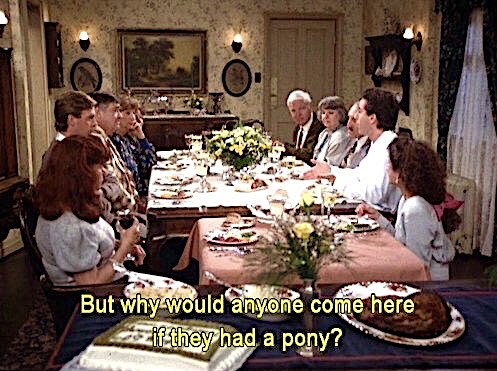
In
advance of the Jewish holiday of Passover (this year
the evening of April 5 to the evening of April 13)
many shops are stocking up on “kosher for Passover”
wines. And because of the wide range of dry and
off-dry bottles now available, observant Jews will
have an excellent opportunity this year to serve
wines with the traditional holiday meal (seder)
other than thick, sweet reds— which are
not a part of Jewish dietary law, but more an
American innovation popularized shortly after
Prohibition, when domestic taste favored sugary
dessert-style reds.
For those wondering what makes a wine
“kosher” and “kosher for Passover,” the answer is that
according to Jewish ritual law a wine labeled Kosher
must meet certain minimal standards, including:
production by sabbath-observant Jews; “fining”
(clarification) only with mineral compounds (not egg
whites or gelatin as usually used, because of the
possibility that it was derived from a non-kosher
animal); supervision of the entire process by a
rabbi; and certification by a recognized group. In
addition, to be “Mevusal”—allowed
to be handled and/or served by non-observant
Jews—the wine must be heated to boiling to
“sterilize it.” Moreover, to be kosher for Passover,
the grapes must be from a vineyard in which no other
crop is grown (because of the possible contamination
from fermentable grains, like wheat, oats, etc.),
and sterilization of the equipment used to make the
wine must be conducted before production to be sure
again it is not contaminated with “fermentable
grains.”
WHITES
While
reds are more traditional for Passover, these whites
feature flavor and the gusto to match typical
appetizers, like deviled eggs, gefilte fish (a
poached mixture of deboned fish), and even chopped
liver, as well as main course items like roasted
chicken and poached or broiled salmon.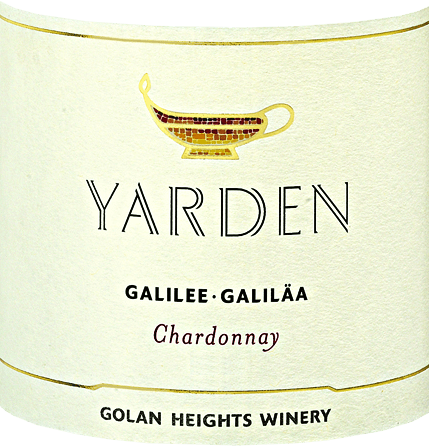
Chardonnay
Made
from grapes grown in Israel’s Golan Heights, the 2021 Yarden
Chardonnay ($24) shows a classic Chablis-like
bouquet and taste of ripe apples and pears, with
notes of pineapple in its crisp finish. Composed of
premium grapes from California’s Russian River
Valley, the 2019
Weinstock Cellars Select Chardonnay ($24) has
a toasty bouquet and taste with undertones of lemon
and vanilla, perfect to pair with gefilte fish and
game birds.
Sauvignon
Blanc
The
2020 Goose
Bay Sauvignon Blanc ($24) from New Zealand
shows a fragrant bouquet and crisp taste of kiwi and
grapefruit, with a zesty finish. And the 2021 Terra
Vega Sauvignon Blanc (a bargain at $12) from
Chile’s Central Valley has a bouquet and taste of
melons and ripe pears, with notes of citrus and
grapefruit in its crisp finish. It would a good
match with gefilte fish.
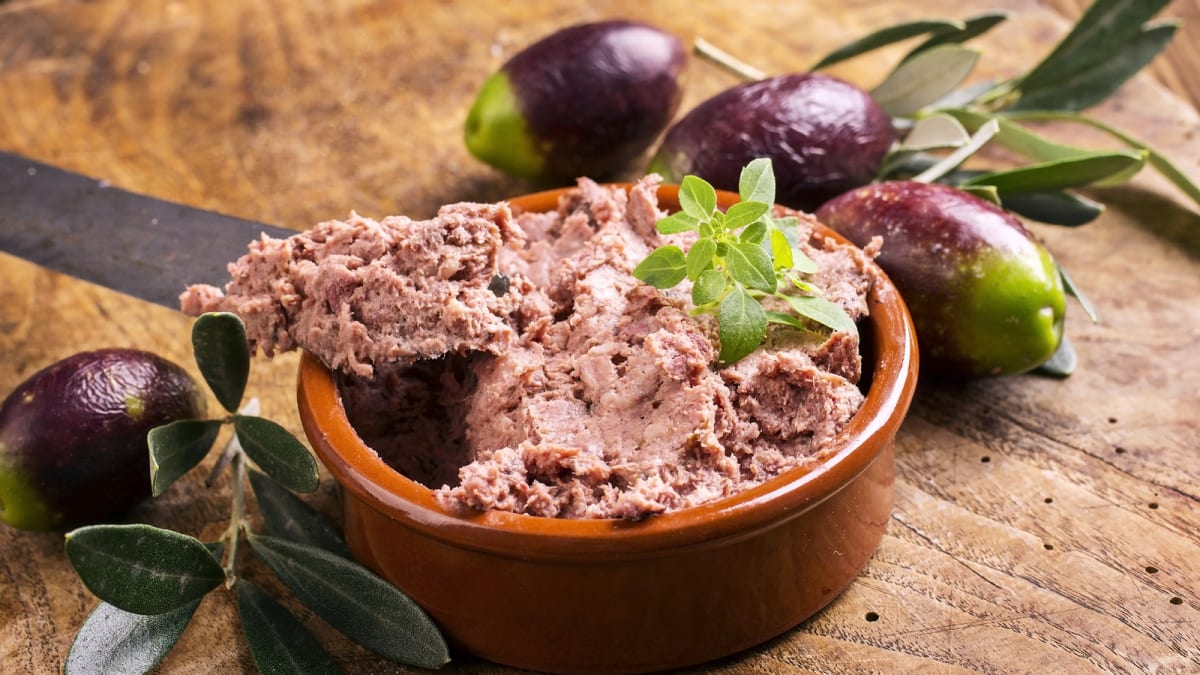
Riesling
and Viognier
The
slightly sweet 2021 Pacifica
Riesling ($22) from Washington State shows
flavors of ripe melons and green apple, with notes
of lime in its vibrant finish. And the 2020 Pacifica
Viognier ($21) has a fragrant bouquet of
honeysuckle and peaches, with a smooth taste of
apricots and some pineapple in its finish. Both
wines make excellent accompaniment to appetizers,
especially deviled eggs and chopped liver (left).
REDS
Bordeaux
The
2019 Château
Camplay Bordeaux Supérieur ($20) was produced
from a blend of Merlot (50%), Cabernet Sauvignon
grapes from France’s Bordeaux region. Following
fermentation, the wine was aged in oak for 8 months.
It has
a distinctive bouquet and taste of ripe plums and
cassis, with hints of herbs in its slightly tannic
finish. 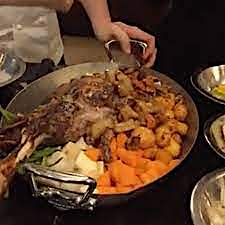
Cabernet
Sauvignon
The
2021 Barkan
Classic Cabernet Sauvignon ($12) was made from
grapes grown in Israel’s Galilee and Golan 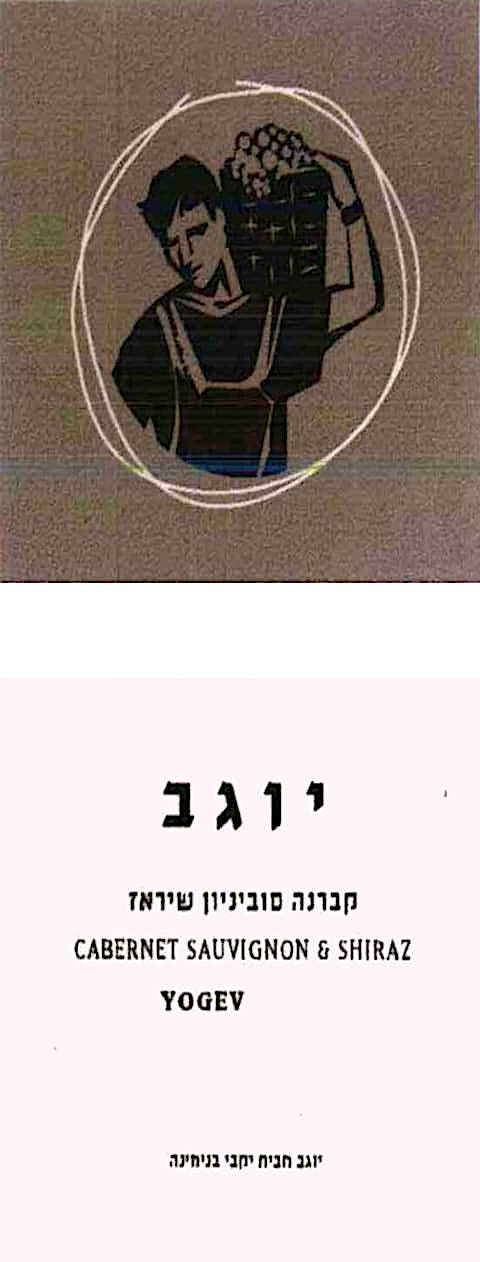 Heights
areas and shows a bouquet and taste of black
currants and ripe plums with notes of oak. And the 2021 Binyama
Yogev Cabernet Sauvignon ($20), also made of
grapes from Israel’s Galilee and Golan Heights
areas, is actually a blend of Cabernet Sauvignon and
Shiraz grapes. It has a fruity bouquet and taste of
ripe plums, blackberries and some cherry, with a
smooth finish. Both wines mate well with main course
items like short ribs of beef and leg of lamb.
Heights
areas and shows a bouquet and taste of black
currants and ripe plums with notes of oak. And the 2021 Binyama
Yogev Cabernet Sauvignon ($20), also made of
grapes from Israel’s Galilee and Golan Heights
areas, is actually a blend of Cabernet Sauvignon and
Shiraz grapes. It has a fruity bouquet and taste of
ripe plums, blackberries and some cherry, with a
smooth finish. Both wines mate well with main course
items like short ribs of beef and leg of lamb.
Pinot
Noir
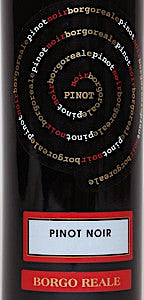 Grapes for the 2020 Borgo
Reale Pinot Noir ($18) came from the rich
Apulian soil in the heel area of Italy. It has a
bouquet and taste of plums and strawberries, with
hints of cranberry in its finish. The 2019 Pacifica
Pinot Noir ($25), made with premium grapes
from Evan’s Vineyard in Oregon, shows a bouquet and
flavor of ripe cherries and spice, with an earthy
finish. Both wines mate particularly well with
braised brisket of beef.
Grapes for the 2020 Borgo
Reale Pinot Noir ($18) came from the rich
Apulian soil in the heel area of Italy. It has a
bouquet and taste of plums and strawberries, with
hints of cranberry in its finish. The 2019 Pacifica
Pinot Noir ($25), made with premium grapes
from Evan’s Vineyard in Oregon, shows a bouquet and
flavor of ripe cherries and spice, with an earthy
finish. Both wines mate particularly well with
braised brisket of beef.
The
2018 Hai
Noah Merlot ($22) is a rich, full-bodied wine
with a bouquet and flavor of raspberries and
cherries, made from grapes grown in Jerusalem’s Judean
Hills. The 2021
Terra Vega Malbec ($12), made of a blend of
mainly Malbec, with small amounts of Alicante
Bouschet and Merlot grapes, all grown in
Chile’s Central Valley, shows a bouquet and taste of
blackberries and cherries, with hints of chocolate
in its lush finish. Both wines make excellent
accompaniment for robust main courses like braised
brisket and leg of lamb as well as short ribs of
beef.
Chianti
and Rioja
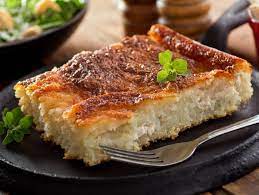 Hailing from the
Castelenuovo Beradenga area of Tuscany, 20 miles
southeast of Florence, the 2020 Terra Di
Seta Chianti Classico ($25) was
fashioned from organically grown grapes (95%
Sangiovese, 5% Cabernet Sauvignon). Following
fermentation, the wine was aged in French oak
barrels for 12 months and shows a bouquet and taste
of cherries and raspberries, with hints of licorice
in its finish. And produced from 100% Tempranillo
grapes grown in vineyards surrounding the town of
Haro in north-central Spain, the 2019 Ramon
Cardova Rioja ($17) shows a bouquet and taste
of ripe wild berries and a touch of balsamic in its
robust finish. These two wines pair harmoniously
with pot roasts, braised beef and potato kugel (left).
Hailing from the
Castelenuovo Beradenga area of Tuscany, 20 miles
southeast of Florence, the 2020 Terra Di
Seta Chianti Classico ($25) was
fashioned from organically grown grapes (95%
Sangiovese, 5% Cabernet Sauvignon). Following
fermentation, the wine was aged in French oak
barrels for 12 months and shows a bouquet and taste
of cherries and raspberries, with hints of licorice
in its finish. And produced from 100% Tempranillo
grapes grown in vineyards surrounding the town of
Haro in north-central Spain, the 2019 Ramon
Cardova Rioja ($17) shows a bouquet and taste
of ripe wild berries and a touch of balsamic in its
robust finish. These two wines pair harmoniously
with pot roasts, braised beef and potato kugel (left).
❖❖❖
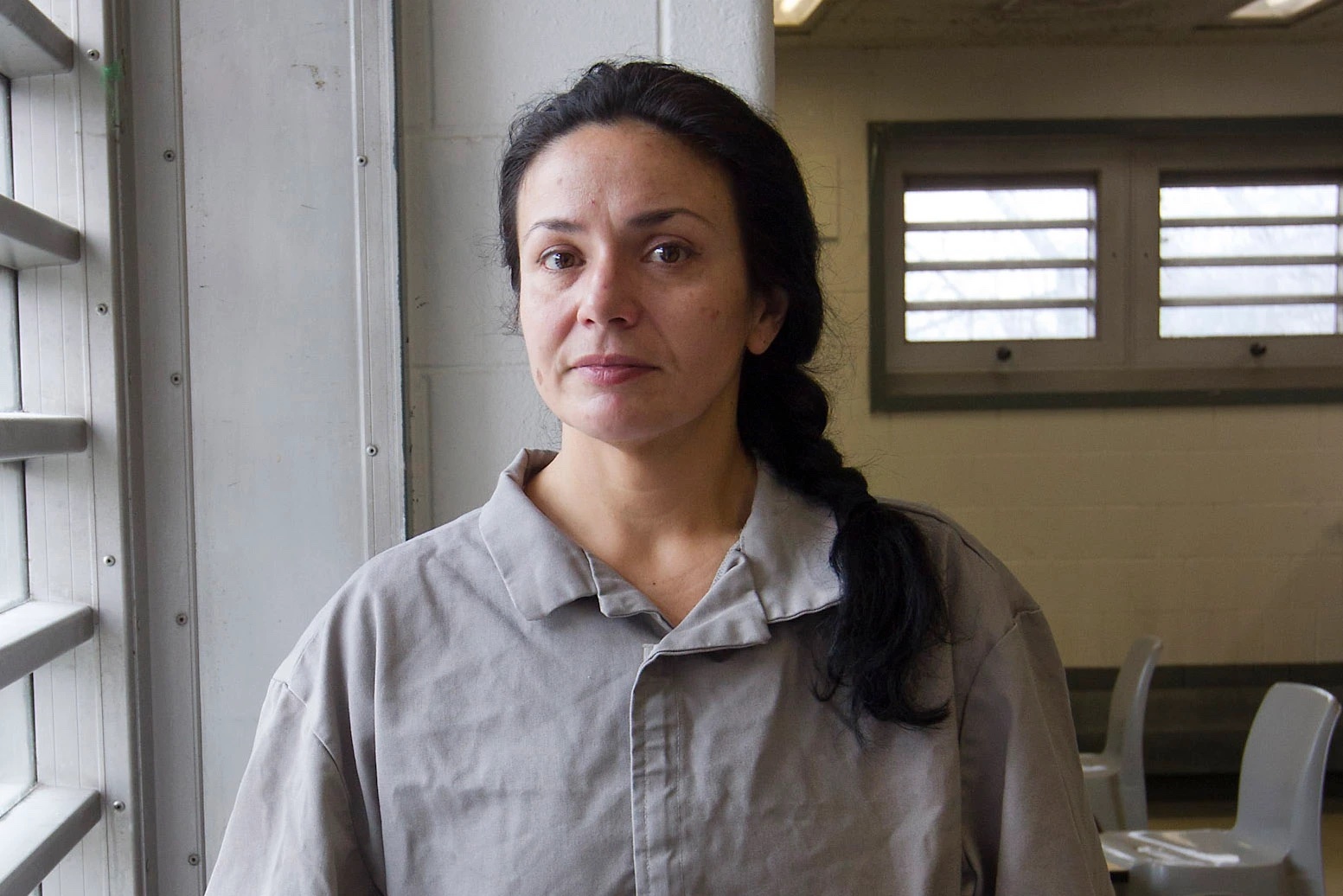 THERE WAS
SOMETHING FISHY ABOUT THAT CHEESECAKE AND SOMETHING
CHEESY ABOUT THAT FISH
THERE WAS
SOMETHING FISHY ABOUT THAT CHEESECAKE AND SOMETHING
CHEESY ABOUT THAT FISH
❖❖❖
Any of John Mariani's books below may be ordered from amazon.com.
 The Hound in Heaven
(21st Century Lion Books) is a novella, and
for anyone who loves dogs, Christmas, romance,
inspiration, even the supernatural, I hope you'll find
this to be a treasured favorite. The story
concerns how, after a New England teacher, his wife and
their two daughters adopt a stray puppy found in their
barn in northern Maine, their lives seem full of promise.
But when tragedy strikes, their wonderful dog Lazarus and
the spirit of Christmas are the only things that may bring
his master back from the edge of despair.
The Hound in Heaven
(21st Century Lion Books) is a novella, and
for anyone who loves dogs, Christmas, romance,
inspiration, even the supernatural, I hope you'll find
this to be a treasured favorite. The story
concerns how, after a New England teacher, his wife and
their two daughters adopt a stray puppy found in their
barn in northern Maine, their lives seem full of promise.
But when tragedy strikes, their wonderful dog Lazarus and
the spirit of Christmas are the only things that may bring
his master back from the edge of despair. WATCH THE VIDEO!
“What a huge surprise turn this story took! I was completely stunned! I truly enjoyed this book and its message.” – Actress Ali MacGraw
“He had me at Page One. The amount of heart, human insight, soul searching, and deft literary strength that John Mariani pours into this airtight novella is vertigo-inducing. Perhaps ‘wow’ would be the best comment.” – James Dalessandro, author of Bohemian Heart and 1906.
“John Mariani’s Hound in Heaven starts with a well-painted portrayal of an American family, along with the requisite dog. A surprise event flips the action of the novel and captures us for a voyage leading to a hopeful and heart-warming message. A page turning, one sitting read, it’s the perfect antidote for the winter and promotion of holiday celebration.” – Ann Pearlman, author of The Christmas Cookie Club and A Gift for my Sister.
“John Mariani’s concise, achingly beautiful novella pulls a literary rabbit out of a hat – a mash-up of the cosmic and the intimate, the tragic and the heart-warming – a Christmas tale for all ages, and all faiths. Read it to your children, read it to yourself… but read it. Early and often. Highly recommended.” – Jay Bonansinga, New York Times bestselling author of Pinkerton’s War, The Sinking of The Eastland, and The Walking Dead: The Road To Woodbury.
“Amazing things happen when you open your heart to an animal. The Hound in Heaven delivers a powerful story of healing that is forged in the spiritual relationship between a man and his best friend. The book brings a message of hope that can enrich our images of family, love, and loss.” – Dr. Barbara Royal, author of The Royal Treatment.
 |
The Encyclopedia of American Food and Drink by John F. Mariani (Bloomsbury USA, $35) Modesty forbids me to praise my own new book, but let me proudly say that it is an extensive revision of the 4th edition that appeared more than a decade ago, before locavores, molecular cuisine, modernist cuisine, the Food Network and so much more, now included. Word origins have been completely updated, as have per capita consumption and production stats. Most important, for the first time since publication in the 1980s, the book includes more than 100 biographies of Americans who have changed the way we cook, eat and drink -- from Fannie Farmer and Julia Child to Robert Mondavi and Thomas Keller. "This book is amazing! It has entries for everything from `abalone' to `zwieback,' plus more than 500 recipes for classic American dishes and drinks."--Devra First, The Boston Globe. "Much needed in any kitchen library."--Bon Appetit. |
"Eating Italian will never be the same after reading John Mariani's entertaining and savory gastronomical history of the cuisine of Italy and how it won over appetites worldwide. . . . This book is such a tasteful narrative that it will literally make you hungry for Italian food and arouse your appetite for gastronomical history."--Don Oldenburg, USA Today. "Italian
restaurants--some good, some glitzy--far
outnumber their French rivals. Many of
these establishments are zestfully described
in How Italian Food Conquered the World, an
entertaining and fact-filled chronicle by
food-and-wine correspondent John F.
Mariani."--Aram Bakshian Jr., Wall Street
Journal.
"Equal parts
history, sociology, gastronomy, and just
plain fun, How Italian Food Conquered the
World tells the captivating and delicious
story of the (let's face it) everybody's
favorite cuisine with clarity, verve and
more than one surprise."--Colman Andrews,
editorial director of The Daily
Meal.com. "A fantastic and fascinating
read, covering everything from the influence
of Venice's spice trade to the impact of
Italian immigrants in America and the
evolution of alta cucina. This book will
serve as a terrific resource to anyone
interested in the real story of Italian
food."--Mary Ann Esposito, host of PBS-TV's
Ciao
Italia. "John Mariani has written the
definitive history of how Italians won their
way into our hearts, minds, and
stomachs. It's a story of pleasure over
pomp and taste over technique."--Danny Meyer,
owner of NYC restaurants Union Square
Cafe, The Modern, and Maialino.
|
 |
 |
 |
 |
 |
 |
MARIANI'S VIRTUAL GOURMET
NEWSLETTER is published weekly. Publisher: John Mariani. Editor: Walter Bagley. Contributing Writers: Christopher
Mariani, Misha Mariani, John A. Curtas, Gerry Dawes, Geoff Kalish.
Contributing
Photographer: Galina Dargery. Technical
Advisor: Gerry
McLoughlin.
If you wish to subscribe to this
newsletter, please click here: http://www.johnmariani.com/subscribe/index.html
© copyright John Mariani 2023
